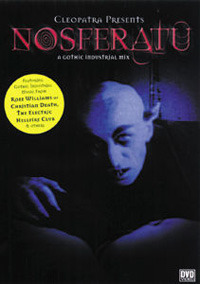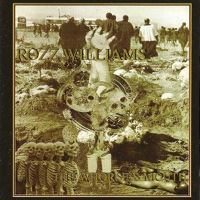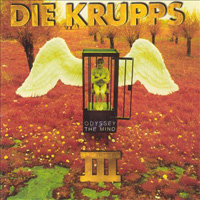 Nosferatu
Nosferatu
with Max Schreck, Alexander Granach, Gustav von Wangenheim
Music by Rozz Williams of Christian Death and The Electric Hellfire Club
Directed by F.W. Murnau
Written by Henrik Galeen, Bram Stoker
(Cleopatra/MVD)
By Eric Johnson
Nosferatu, FW Murneau’s unforgettable, unauthorized adaptation of Bram Stoker’s Dracula, was originally produced in 1922 and stands to this day as the darkest and most aesthetically striking take on the vampiric tale committed to celluloid. One of a tiny handful of silent-era films still widely distributed, this DVD reissue replaces the film’s unremarkable original soundtrack with a vastly improved hypnotic Gothic industrial mix. While it is a visually stunning, genuinely frightening, and utterly spellbinding vampire film, Nosferatu is not as good a movie as short clips of it would lead you to expect.
Most of what is brilliant about it comes in the form of Max Shreck, the actor whose unparalleled presence is the primary reason for this film’s longevity. Shreck’s Count is an unnerving, grotesque, elongated, desperate, and hypnotic creature whose rodent-like features reflect not the slightest hint of romance or charisma. He is more akin to the Carpathian folk tale than the portrayals of Bela Lagousi, Christopher Lee, or Gary Oldman. He is a glimpse into a time and place where vampires were not fantasized about, but genuinely feared. His countenance evokes images of old women in black dresses crossing themselves. His is, without a doubt, the least human and most unsympathetic portrayal of the vampire ever put on film.
As for the remainder of the film, it’s a real mixed bag. It seems longer than the 63 minute running time. This is primarily because it was made at a time when movies were still new enough to be inherently engrossing with relatively little concern for pacing, but the story is very stripped down in comparison to the novel. The acting is also quite hammy. Most hyperactive and bizarre are the actors who portray Dracula’s mad servant Renfield and Johnathan Harker. The actress playing Mina seems perpetually doped up and surprisingly androgynous; like a performer at a Weimar republic dance club. It is, however, an effective horror film because it’s so visually strong. In rewriting the film in order to avoid a lawsuit, Murneau made the film take place in Germany and renamed all of the characters. This has the dual effect of bringing the film geographically closer to the setting of the original folk tales and giving us a glimpse of Germany saturated with the ghosts of one world war and doomed to destruction in the next. It is the only film version of Dracula where Mina dies, it takes place during a plague, its vampire is mishappen and unromantic, and it is by far the darkest take on Stoker’s immortal novel.
The new soundtrack consists of music previously released on vampire-themed Gothic mixes released by Cleopatra Records. Contributing artists include Rozz Williams (of Christian Death) and The Electric Hellfire Club. There aren’t really songs so much as hypnotic sampling of chanting, electronic sounds, slow industrial beats, and church organs. It’s a huge improvement over the original soundtrack and really enhances the film. Making poorly-executed scenes drip with atmosphere, the soundtrack adds menace and foreshadowing and makes the great moments of the film spellbinding. It actually makes the film the classic one might have expected in the first place. It doesn’t come without a spoonful of irony though. After all, Gothic kids sit there, fantasizing about being vampires and here is cinema’s most mishappen, least attractive, and least enviable vampire staring out from the abyss.
(www.musicvideodistributors.com)



